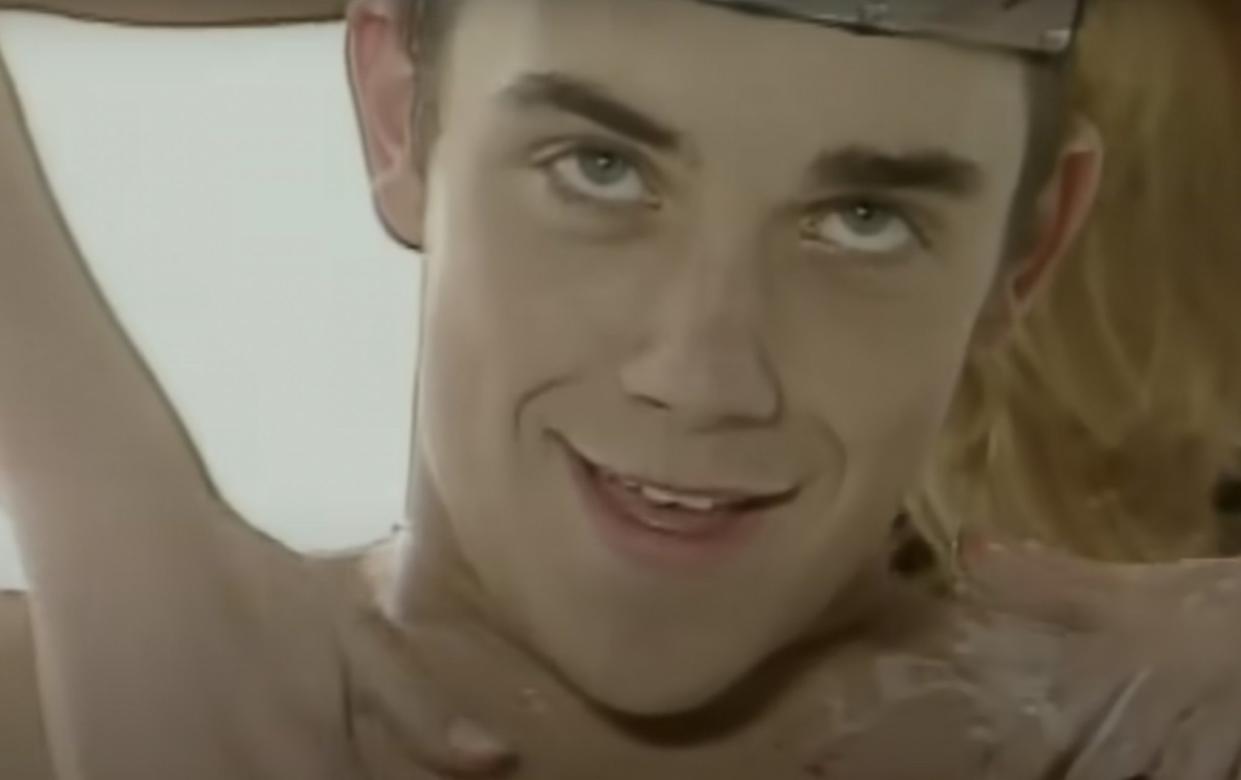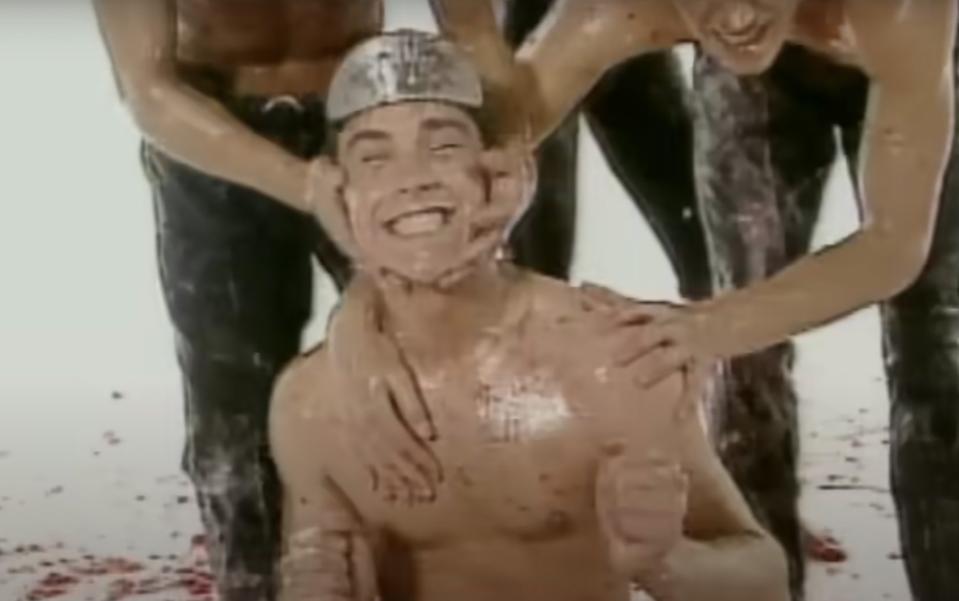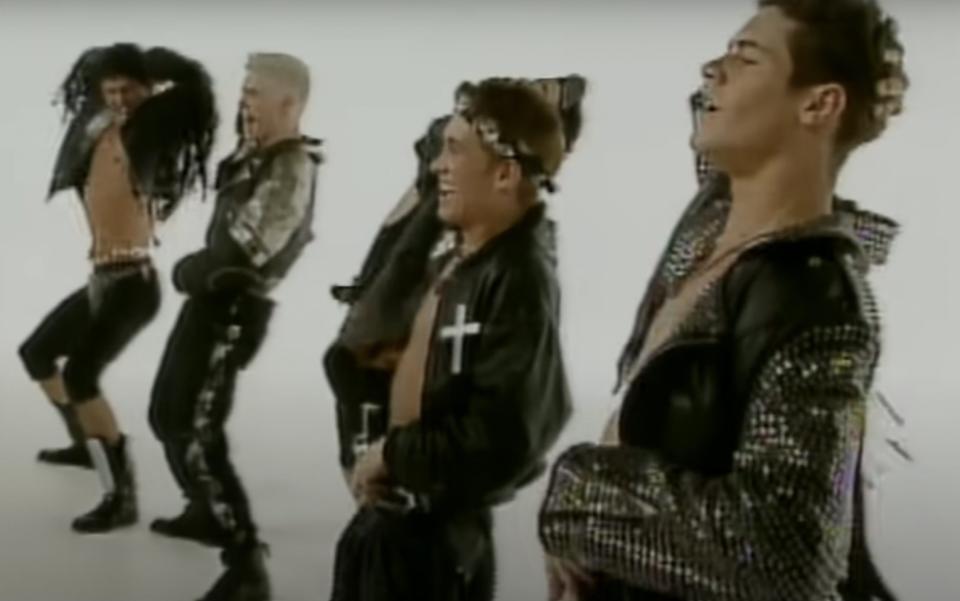‘It wasn’t exactly porn’: the eye-popping true story of Take That’s ‘banned’ debut video

Take That’s ninth album This Life, released 24 Nov, is a mature record of sophisticated and Radio 2-friendly pop music, as befits a former boy band now in their fifties. As Gary Barlow, Howard Donald and Mark Owen toast the launch of their latest release, it’s highly unlikely that they’re thinking back to the slightly-less-sophisticated launch of their first ever single in 1991.
But we are. And specifically the accompanying music video. The promotional film for Do What U Like remains one of the most jaw-dropping spectacles in pop history.
The video sticks in the mind as a series of snapshots. Wobbly jelly. Naked buttocks. Wobbly jelly on naked buttocks. Bondage gear with studded leather codpieces. Cheesy Nineties rave dancing. Ice lolly nipple tickles. Custard massages. Naked jelly on wobbly buttocks. The video shows a group desperately trying to make a splash. It worked, eventually: Take That, who were then a five-piece including Robbie Williams and Jason Orange, would become the most successful boy band in UK chart history. But not before this opening visual salvo was banned from daytime television and the single sank without trace in the charts. Still, nothing ventured, nothing gained.
As Barlow reflected years later, “I never thought I’d be doing anything like that.” Donald had a more specific memory of the Do What U Like video. “I was cleaning jelly out of my a–ehole for the next two years after that video,” he told a later documentary about the band, For The Record.
The video was directed by the duo of former Radio 1 DJ Rosemary “Ro” Barratt and TV executive Angie Smith. Both knew the band’s manager Nigel Martin-Smith via the pop music ecosystem around Manchester in the late Eighties and early Nineties. “At the time I was a producer on [dance music programme] The Hitman and Her at Granada Television. I got to know Nigel because he was managing different artists,” recalls Barratt. One such artist was Damian, who had a hit with a 1989 cover of the Time Warp from The Rocky Horror Show. It was when Damian appeared on a live version of kids’ show the Wide Awake Club, another programme that Barratt worked on, that she bonded with Martin-Smith.
“We’d meet regularly and he’d talk to me about how he wanted to create the UK version of New Kids on the Block. He was looking for potential young boys to audition. Because I worked on The Hitman and Her, I knew Jason [Orange] really well as he was a dancer on the programme. That’s where the link with The Hitman and Her came in. He had a dancing partner, Mark [Owen]. At the time Jason was a painter and decorator for Wythenshawe Council.”
Barratt told Orange that Martin-Smith was looking for people and should apply. Martin-Smith – who wanted the band to dance and look good – duly put a group together, built around a bright young songwriter he also managed called Gary Barlow. “The rest is history,” says Barratt. Well, not quite. There was the small matter of the band’s debut video to shoot.
One of Barratt’s friends was Smith, who was a director and producer on The Hitman and Her. Martin-Smith duly asked the pair to direct Take That’s first ever video. Do What U Like song was a lightweight slice of ravey pop, released in the summer of 1991 on Martin-Smith’s independent Dance UK label. “Everything was worked out -– the dance routine and the clothes. He just wanted us to film it,” says Barratt. The budget was £5,000.
The initial concept was simple. The band, dressed on faux black bondage gear with silver studs, would dance in front of a white screen. “It was a very hard image. Lots of black leather. The reason was that they’d done a lot of touring in the gay clubs and they’d been getting a really good reception. Jason had biker boots, they had the fringed leather jackets, there were some gay connotations, let’s say. It was a sort of tough guy approach. New Kids on the Block had that imagery. That was what [Nigel] wanted,” says Barratt. So far, so run-of-the-mill. But there was a problem. With black leather and a white background, the concept felt terribly monochrome. So Smith had an idea.

“I’ve no idea how she came up with this. But she said, ‘Oh, what about if we got some jelly to add some colour,’” says Barratt, laughing. Trays of different coloured jelly and canisters of foam custard were therefore procured for the shoot. The band were “amenable” to the introduction of food. “Obviously it was their first ever video. They were excited, they were giddy as kippers, really,” says Barratt.
Speaking from LA, where she’s a TV executive, music video director Smith says the idea behind the jelly was “to get some press” to help the fledgling band. “They were trying to break through so I thought if we did something a bit saucy it could help get them some attention. I just came up with the idea of putting a wobbling bit of jelly on a bum cheek,” she says. “It’s not really porn, it’s more just cheeky, wasn’t it?”
Shot on 21 June 1991 at the Vector Television studios in the Stockport suburb of Heaton Mersey, the video is a sticky, tacky, feelgood, jaw-dropping spectacle. Many tropes were of the time. The video features multiple so-called crash zooms – when the camera moves in very quickly. But as the song progresses, the band slowly remove the scant items of clothing they started with. Their tightly-choreographed dance routine descends into a food fight. Globules of jelly fly through the air and hang suggestively from naked flesh. The video is intercut with shots of the band being massaged with canned custard by female models in little black dresses. The models also clean jelly off the band’s naked bottoms with an old-fashioned mop. One of them tickles Barlow’s nipples with a Mini Milk ice lolly. In one scene, all five members of Take That lie face down on the floor and – in one movement – remove their tiny towels to reveal what would soon become the ten most desirable buttocks in late-twentieth century British pop culture.

Smith says that this shot – the five-bum salute, if you will – was actually an “audition” for which band member’s bottom would be used for a jelly close-up shot. They all lay down and “whipped” their towels off. Smith claims she can’t recall whose posterior was eventually used.
The band were very easy to deal with, the video-makers say. “I always remember Gary being a little bit more shy about getting his kit off than the rest of them. Howard [Donald] was particularly engaging and very forthright. He didn’t mind showing off his bits,” says Barratt. Smith thinks it was Owen’s mum who actually brought the jelly and the ice lollies to the shoot.
Williams emerged as the joker of the pack. “Him and Howard were walking across the set with the mops, doing funny dances and walks. Robbie was a natural comedian. He was only 16,” says co-director Barratt.
The shoot wasn’t straightforward due to the sequencing. “Once you bring in jelly to anything you can’t go back and redo things. The jelly caused us a major problem because once the band got into it, it was being thrown left, right and centre. The studio was quite expensive and pink jelly marks ended up on the cyc [the white background screen],” says Barratt. They spent hours cleaning up and went home concerned that they’d get a bill from the studio.

The shoot over, Martin-Smith arranged an after-video celebration in a nearby venue. He invited the press. Barlow played Elton John songs on the piano and Williams did Norman Wisdom and Frank Spencer impressions. The band all watched the edit of the video some days later. Martin-Smith had numerous video tapes of it made. But such was the shoestring budget on which Martin-Smith was operating that he asked the band “to cough up a tenner each to get a copy of their own video”, Barratt says. They all ponied up. “This was the first time they’d seen anything produced for themselves. Sat watching the video, they were so excited. I remember that being really nice,” she says. Smith confirms this story.
The video was immediately banned from daytime TV due to the nakedness. Barratt and Smith therefore had to cut a sanitised version with the more risqué shots removed so it could be used on children’s television. This added to the overall cost.
Disappointingly for the band Do What U Like flopped, stalling at number 82 in the singles charts. It wouldn’t be until Take That’s next single, Promises, that the band would have their first Top 40 hit. But – crucially, and as per Smith’s wish -– the video got them noticed by Smash Hits.
“They’ve come to saucify the nation with their barnstorming dance sensation Do What U Like,” the magazine wrote in July 1991. “Although they’ve only been together for two months, Take That’s “steamy” performances in nightclubs up and down the length of the country have, as they say, been causing “major sensations”.” The magazine also compared them favourably to another boy band of the day: “Are they the new Big Fun? Oh no, they’re much better.”
Speaking years later, Robbie Williams talked about the shoot in disbelief. “I got my a–e wiped off with a mop and loads of jelly as me and four or my mates lay on our fronts naked,” he said. “As a song it’s not brilliant but it got us noticed,” Barlow has said.
Barratt is chuffed that the video played a small part in the band’s success (she says the outtakes, which she kept until recently, were even more outrageous). As a “thank you”, Barratt says Martin-Smith asked her if she’d like Take That to perform at her upcoming wedding. Her husband wasn’t keen so she declined. Both Barratt and Smith remain connected to the local music scene. Barratt has launched the Stockport Music Map, a map of the town’s notable musical landmarks (it features Take That, 10cc and Blossoms who formed in Stockport, while The Smiths and the Stone Roses recorded there). Smith, meanwhile, was married to the late Paul Ryder from the Happy Mondays, who died last year. She has a podcast called the Paul Ryder Tapes comprising in-depth interviews with Ryder, recorded before he died.
Smith says that the whole point of the video was to cause a stir. “And it absolutely did. It got banned from Saturday morning telly. That was exactly the point of what we were trying to do,” she says.
This Life (EMI) is out now
